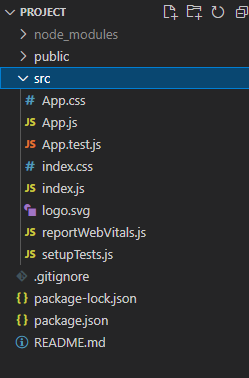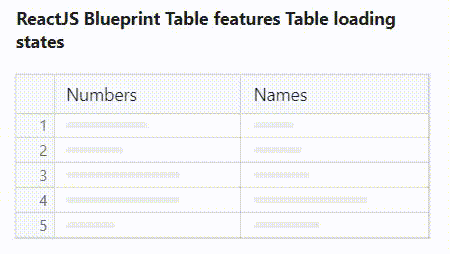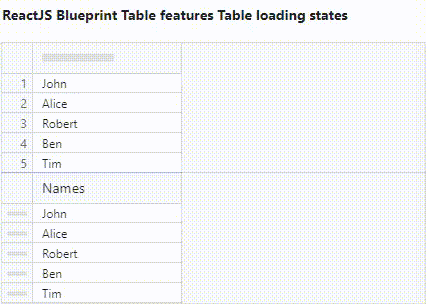React.js蓝图表格特性 表格加载状态
React.js 蓝图是一个前端UI工具包。用于构建桌面应用程序中复杂数据密集的界面非常高效且流行。
表格组件允许用户显示数据行。我们可以在ReactJS中使用以下方法来使用ReactJS蓝图表格组件。
表格组件的 loadingOptions 属性设置了组件中的加载状态。它接受列表作为输入,可以设置列头、行头或单元格的加载状态。TableLoadingOption.COLUMN_HEADERS设置列头的加载状态,TableLoadingOption.ROW_HEADERS设置行头的加载状态,TableLoadingOption.CELL将单元格的状态设置为加载状态。
表格属性:
- numRows: 用于设置行数。
- cellRenderer: 用于定义数据的显示方式,可以在每个列组件上进行设置。
语法:
<Table loadingOptions={{]}></Table>
先决条件:
- 介绍和安装 reactJS
- React.js 蓝图表格组件
创建React应用程序并安装模块:
步骤1: 使用以下命令创建一个React应用程序:
npx create-react-app foldername
步骤2: 创建项目文件夹,例如foldername,使用以下命令进入该文件夹:
cd foldername
步骤3: 在创建ReactJS应用程序之后,使用以下命令安装所需的模块:
npm install @blueprintjs/core
npm install --save @blueprintjs/table
项目结构: 它将如下所示。

Example1: 我们从“@blueprintjs/table”中导入{Column,Table,TableLoadingOption,Cell}。为了应用组件的默认样式,我们导入了“@blueprintjs/core/lib/css/blueprint.css”和“@blueprintjs/table/lib/css/table.css”。我们创建了两个自定义函数sampleDataOne和sampleDataTwo,第一个函数返回一个单元格来显示示例数字,第二个函数从我们创建的名为names的列表中返回一个名称。对于这两个列组件,我们传递了name prop来显示列的名称,cellRenderer,对于Table组件,我们传递了loadingOptions作为TableLoadingOption.CELLS。
App.js
import React from 'react'
import '@blueprintjs/core/lib/css/blueprint.css';
import '@blueprintjs/table/lib/css/table.css';
import { Column, Table, Cell, TableLoadingOption }
from "@blueprintjs/table";
function App() {
const names = ["John", "Alice", "Robert", "Ben", "Tim"];
const sampleDataOne = (idx) => {
return <Cell>{idx * 100 + 4 + idx}</Cell>
};
const sampleDataTwo = (idx) => {
return <Cell>{names[idx]}</Cell>
};
return (
<div style={{ margin: 20 }}>
<h4>ReactJS Blueprint Table
features Table loading states</h4>
<Table numRows={5}
loadingOptions={[TableLoadingOption.CELLS]}
>
<Column
name=" Numbers"
cellRenderer={sampleDataOne} />
<Column
name="Names"
cellRenderer={sampleDataTwo} />
</Table>
</div>
);
}
export default App;
运行应用程序的步骤: 从项目的根目录中使用以下命令运行应用程序:
npm start
输出: 现在打开你的浏览器,访问 http://localhost:3000/ ,你将会看到以下的输出:

示例2: 在这个示例中,我们添加了两个表,numRows={5},在两个表中,我们添加了一个具有相同名称的列,并通过cellRenderer属性传递了相同的自定义函数sampleData,该函数从我们创建的names列表返回一个名称。在第一个Table组件中,我们将loadingOptions作为TableLoadingOption.COLUMN_HEADERS传递。在第二个Table组件中,我们将loadingOptions作为TableLoadingOption.ROW_HEADERS传递。
App.js
import React from 'react'
import '@blueprintjs/core/lib/css/blueprint.css';
import '@blueprintjs/table/lib/css/table.css';
import { Column, Table, Cell, TableLoadingOption }
from "@blueprintjs/table";
function App() {
const names = ["John", "Alice", "Robert", "Ben", "Tim"];
const sampleData = (idx) => {
return <Cell>{names[idx]}</Cell>
};
return (
<div style={{ margin: 20 }}>
<h4>ReactJS Blueprint Table features
Table loading states</h4>
<Table numRows={5}
loadingOptions=
{[TableLoadingOption.COLUMN_HEADERS]}
>
<Column
name="Names"
cellRenderer={sampleData} />
</Table>
<Table numRows={5}
loadingOptions={[TableLoadingOption.ROW_HEADERS]}
>
<Column
name="Names"
cellRenderer={sampleData} />
</Table>
</div>
);
}
export default App;
运行应用程序的步骤: 从项目的根目录中使用以下命令运行应用程序:
npm start
输出: 现在打开你的浏览器并转到 http://localhost:3000/ ,你将看到以下的输出:

参考: https://blueprintjs.com/docs/versions/1/#table-js.table-loading-states
 极客教程
极客教程